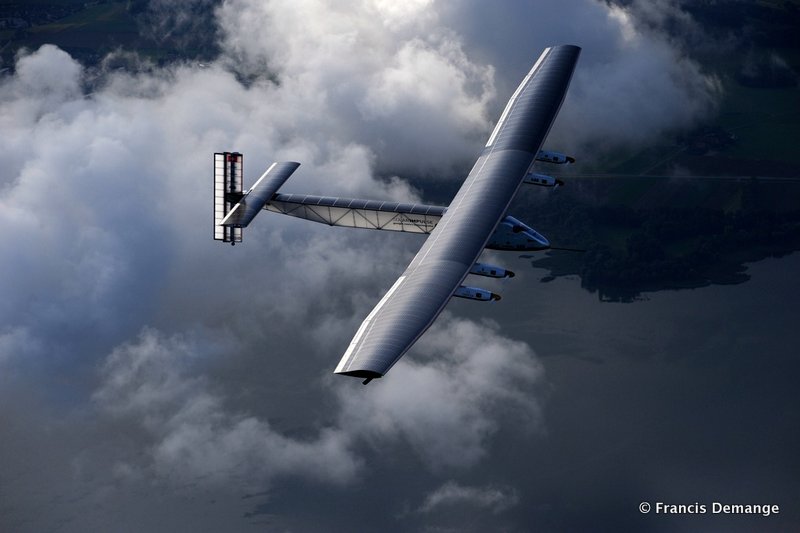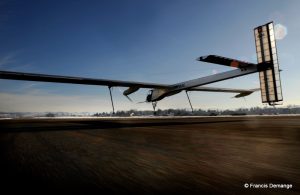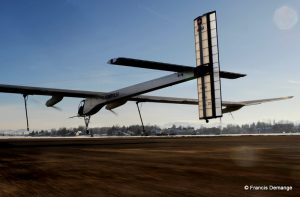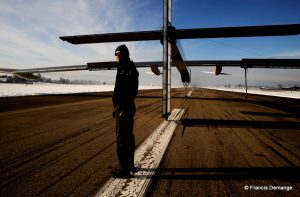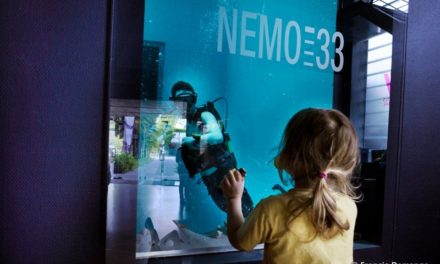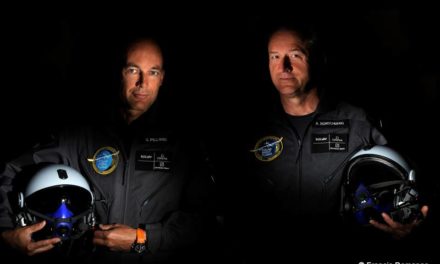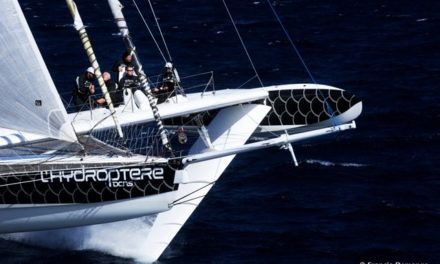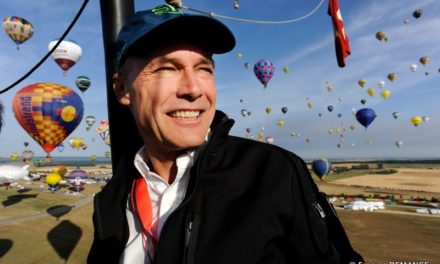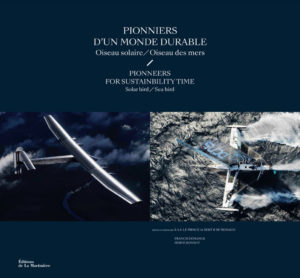Dubendorf Airfield, 3 December 2009. At 13:11 , the Solar Impulse HB-SIA, the first airplane designed to fly day and night without fuel, left the ground for the first time.
The results of the ground tests conducted these last few weeks to verify numerous parameters (the prototype’s controllability, acceleration, braking paths and, engine power) had been overwhelming positive, thereby leading the team to give the go-ahead to Markus Scherdel, the test pilot, to take the prototype up to its take-off speed.
As the aircraft gently took up speed, the huge wing of the Solar Impulse gradually rose into the air under intense admiration of the project promoters, Bertrand Piccard and André Borschberg. After some 350 metres of flight at an altitude of one meter, the prototype graciously landed on the centre of the runway, triggering a frenzied applause from the team.
“On the one hand I find it terrific to see a dream come true. For over ten years now, I have dreamt of a solar aircraft capable of flying day and night without fuel – and promoting renewable energy. Today, our plane took off and was airborne for the very first time. This is an unbelievable and unforgettable moment! On the other hand, I remain humble in the face of the difficult journey still to be accomplished – it’s a long way between these initial tests and a circumnavigation of the world”, commented Bertrand Piccard, initiator and President of Solar Impulse.
“This is the culmination of 6 years of intense work by a very experienced team of professionals! This first “flea hop” successfully completes the first phase of Solar Impulse, confirming our technical choices. We are now ready to start the next phase – the actual flight tests”, said Andre Borschberg, co-founder and CEO of Solar Impulse.
- the Solar Impulse HB-SIA, the first airplane designed to fly day and night without fuel, left the ground for the first time. The results of the ground tests conducted these last few weeks to verify numerous parameters (the prototypeÕs controllability, acceleration, braking paths and, engine power) had been overwhelming positive, thereby leading the team to give the go-ahead to Markus Scherdel, the test pilot, to take the prototype up to its take-off speed. As the aircraft gently took up speed, the huge wing of the Solar Impulse gradually rose into the air under intense admiration of the project promoters, Bertrand Piccard and Andr Borschberg. After some 350 metres of flight at an altitude of one meter, the prototype graciously landed on the centre of the runway, triggering a frenzied applause from the team. “On the one hand I find it terrific to see a dream come true. For over ten years now, I have dreamt of a solar aircraft capable of flying day and night without fuel – and promoting renewable energy. Today, our plane took off and was airborne for the very first time. This is an unbelievable and unforgettable moment! On the other hand, I remain humble in the face of the difficult journey still to be accomplished Ð itÕs a long way between these initial tests and a circumnavigation of the worldÓ, commented Bertrand Piccard, initiator and President of Solar Impulse. “This is the culmination of 6 years of intense work by a very experienced team of professionals! This first Òflea hopÓ successfully completes the first phase of Solar Impulse, confirming our technical choices. We are now ready to start the next phase Ð the actual flight tests”, said Andre Borschberg, co-founder and CEO of Solar Impulse.
- Dubendorf Airfield, 3 December 2009. At 13:11 , the Solar Impulse HB-SIA, the first airplane designed to fly day and night without fuel, left the ground for the first time. The results of the ground tests conducted these last few weeks to verify numerous parameters (the prototypeÕs controllability, acceleration, braking paths and, engine power) had been overwhelming positive, thereby leading the team to give the go-ahead to Markus Scherdel, the test pilot, to take the prototype up to its take-off speed. As the aircraft gently took up speed, the huge wing of the Solar Impulse gradually rose into the air under intense admiration of the project promoters, Bertrand Piccard and Andr Borschberg. After some 350 metres of flight at an altitude of one meter, the prototype graciously landed on the centre of the runway, triggering a frenzied applause from the team. “On the one hand I find it terrific to see a dream come true. For over ten years now, I have dreamt of a solar aircraft capable of flying day and night without fuel – and promoting renewable energy. Today, our plane took off and was airborne for the very first time. This is an unbelievable and unforgettable moment! On the other hand, I remain humble in the face of the difficult journey still to be accomplished Ð itÕs a long way between these initial tests and a circumnavigation of the worldÓ, commented Bertrand Piccard, initiator and President of Solar Impulse. “This is the culmination of 6 years of intense work by a very experienced team of professionals! This first Òflea hopÓ successfully completes the first phase of Solar Impulse, confirming our technical choices. We are now ready to start the next phase Ð the actual flight tests”, said Andre Borschberg, co-founder and CEO of Solar Impulse.
- Dubendorf Airfield, 3 December 2009. At 13:11 , the Solar Impulse HB-SIA, the first airplane designed to fly day and night without fuel, left the ground for the first time. The results of the ground tests conducted these last few weeks to verify numerous parameters (the prototypeÕs controllability, acceleration, braking paths and, engine power) had been overwhelming positive, thereby leading the team to give the go-ahead to Markus Scherdel, the test pilot, to take the prototype up to its take-off speed. As the aircraft gently took up speed, the huge wing of the Solar Impulse gradually rose into the air under intense admiration of the project promoters, Bertrand Piccard and Andr Borschberg. After some 350 metres of flight at an altitude of one meter, the prototype graciously landed on the centre of the runway, triggering a frenzied applause from the team. “On the one hand I find it terrific to see a dream come true. For over ten years now, I have dreamt of a solar aircraft capable of flying day and night without fuel – and promoting renewable energy. Today, our plane took off and was airborne for the very first time. This is an unbelievable and unforgettable moment! On the other hand, I remain humble in the face of the difficult journey still to be accomplished Ð itÕs a long way between these initial tests and a circumnavigation of the worldÓ, commented Bertrand Piccard, initiator and President of Solar Impulse. “This is the culmination of 6 years of intense work by a very experienced team of professionals! This first Òflea hopÓ successfully completes the first phase of Solar Impulse, confirming our technical choices. We are now ready to start the next phase Ð the actual flight tests”, said Andre Borschberg, co-founder and CEO of Solar Impulse.
- Dubendorf Airfield, 3 December 2009. At 13:11 , the Solar Impulse HB-SIA, the first airplane designed to fly day and night without fuel, left the ground for the first time. The results of the ground tests conducted these last few weeks to verify numerous parameters (the prototypeÕs controllability, acceleration, braking paths and, engine power) had been overwhelming positive, thereby leading the team to give the go-ahead to Markus Scherdel, the test pilot, to take the prototype up to its take-off speed. As the aircraft gently took up speed, the huge wing of the Solar Impulse gradually rose into the air under intense admiration of the project promoters, Bertrand Piccard and Andr Borschberg. After some 350 metres of flight at an altitude of one meter, the prototype graciously landed on the centre of the runway, triggering a frenzied applause from the team. “On the one hand I find it terrific to see a dream come true. For over ten years now, I have dreamt of a solar aircraft capable of flying day and night without fuel – and promoting renewable energy. Today, our plane took off and was airborne for the very first time. This is an unbelievable and unforgettable moment! On the other hand, I remain humble in the face of the difficult journey still to be accomplished Ð itÕs a long way between these initial tests and a circumnavigation of the worldÓ, commented Bertrand Piccard, initiator and President of Solar Impulse. “This is the culmination of 6 years of intense work by a very experienced team of professionals! This first Òflea hopÓ successfully completes the first phase of Solar Impulse, confirming our technical choices. We are now ready to start the next phase Ð the actual flight tests”, said Andre Borschberg, co-founder and CEO of Solar Impulse.
- Dubendorf Airfield, 3 December 2009. At 13:11 , the Solar Impulse HB-SIA, the first airplane designed to fly day and night without fuel, left the ground for the first time. The results of the ground tests conducted these last few weeks to verify numerous parameters (the prototypeÕs controllability, acceleration, braking paths and, engine power) had been overwhelming positive, thereby leading the team to give the go-ahead to Markus Scherdel, the test pilot, to take the prototype up to its take-off speed. As the aircraft gently took up speed, the huge wing of the Solar Impulse gradually rose into the air under intense admiration of the project promoters, Bertrand Piccard and Andr Borschberg. After some 350 metres of flight at an altitude of one meter, the prototype graciously landed on the centre of the runway, triggering a frenzied applause from the team. “On the one hand I find it terrific to see a dream come true. For over ten years now, I have dreamt of a solar aircraft capable of flying day and night without fuel – and promoting renewable energy. Today, our plane took off and was airborne for the very first time. This is an unbelievable and unforgettable moment! On the other hand, I remain humble in the face of the difficult journey still to be accomplished Ð itÕs a long way between these initial tests and a circumnavigation of the worldÓ, commented Bertrand Piccard, initiator and President of Solar Impulse. “This is the culmination of 6 years of intense work by a very experienced team of professionals! This first Òflea hopÓ successfully completes the first phase of Solar Impulse, confirming our technical choices. We are now ready to start the next phase Ð the actual flight tests”, said Andre Borschberg, co-founder and CEO of Solar Impulse.
- Dubendorf Airfield, 3 December 2009. At 13:11 , the Solar Impulse HB-SIA, the first airplane designed to fly day and night without fuel, left the ground for the first time. The results of the ground tests conducted these last few weeks to verify numerous parameters (the prototypeÕs controllability, acceleration, braking paths and, engine power) had been overwhelming positive, thereby leading the team to give the go-ahead to Markus Scherdel, the test pilot, to take the prototype up to its take-off speed. As the aircraft gently took up speed, the huge wing of the Solar Impulse gradually rose into the air under intense admiration of the project promoters, Bertrand Piccard and Andr Borschberg. After some 350 metres of flight at an altitude of one meter, the prototype graciously landed on the centre of the runway, triggering a frenzied applause from the team. “On the one hand I find it terrific to see a dream come true. For over ten years now, I have dreamt of a solar aircraft capable of flying day and night without fuel – and promoting renewable energy. Today, our plane took off and was airborne for the very first time. This is an unbelievable and unforgettable moment! On the other hand, I remain humble in the face of the difficult journey still to be accomplished Ð itÕs a long way between these initial tests and a circumnavigation of the worldÓ, commented Bertrand Piccard, initiator and President of Solar Impulse. “This is the culmination of 6 years of intense work by a very experienced team of professionals! This first Òflea hopÓ successfully completes the first phase of Solar Impulse, confirming our technical choices. We are now ready to start the next phase Ð the actual flight tests”, said Andre Borschberg, co-founder and CEO of Solar Impulse.
- Dubendorf Airfield, 3 December 2009. At 13:11 , the Solar Impulse HB-SIA, the first airplane designed to fly day and night without fuel, left the ground for the first time. The results of the ground tests conducted these last few weeks to verify numerous parameters (the prototypeÕs controllability, acceleration, braking paths and, engine power) had been overwhelming positive, thereby leading the team to give the go-ahead to Markus Scherdel, the test pilot, to take the prototype up to its take-off speed. As the aircraft gently took up speed, the huge wing of the Solar Impulse gradually rose into the air under intense admiration of the project promoters, Bertrand Piccard and Andr Borschberg. After some 350 metres of flight at an altitude of one meter, the prototype graciously landed on the centre of the runway, triggering a frenzied applause from the team. “On the one hand I find it terrific to see a dream come true. For over ten years now, I have dreamt of a solar aircraft capable of flying day and night without fuel – and promoting renewable energy. Today, our plane took off and was airborne for the very first time. This is an unbelievable and unforgettable moment! On the other hand, I remain humble in the face of the difficult journey still to be accomplished Ð itÕs a long way between these initial tests and a circumnavigation of the worldÓ, commented Bertrand Piccard, initiator and President of Solar Impulse. “This is the culmination of 6 years of intense work by a very experienced team of professionals! This first Òflea hopÓ successfully completes the first phase of Solar Impulse, confirming our technical choices. We are now ready to start the next phase Ð the actual flight tests”, said Andre Borschberg, co-founder and CEO of Solar Impulse.
- Dubendorf Airfield, 3 December 2009. At 13:11 , the Solar Impulse HB-SIA, the first airplane designed to fly day and night without fuel, left the ground for the first time. The results of the ground tests conducted these last few weeks to verify numerous parameters (the prototypeÕs controllability, acceleration, braking paths and, engine power) had been overwhelming positive, thereby leading the team to give the go-ahead to Markus Scherdel, the test pilot, to take the prototype up to its take-off speed. As the aircraft gently took up speed, the huge wing of the Solar Impulse gradually rose into the air under intense admiration of the project promoters, Bertrand Piccard and Andr Borschberg. After some 350 metres of flight at an altitude of one meter, the prototype graciously landed on the centre of the runway, triggering a frenzied applause from the team. “On the one hand I find it terrific to see a dream come true. For over ten years now, I have dreamt of a solar aircraft capable of flying day and night without fuel – and promoting renewable energy. Today, our plane took off and was airborne for the very first time. This is an unbelievable and unforgettable moment! On the other hand, I remain humble in the face of the difficult journey still to be accomplished Ð itÕs a long way between these initial tests and a circumnavigation of the worldÓ, commented Bertrand Piccard, initiator and President of Solar Impulse. “This is the culmination of 6 years of intense work by a very experienced team of professionals! This first Òflea hopÓ successfully completes the first phase of Solar Impulse, confirming our technical choices. We are now ready to start the next phase Ð the actual flight tests”, said Andre Borschberg, co-founder and CEO of Solar Impulse.
- Bertrand Piccard. Dubendorf Airfield, 3 December 2009. At 13:11 , the Solar Impulse HB-SIA, the first airplane designed to fly day and night without fuel, left the ground for the first time. The results of the ground tests conducted these last few weeks to verify numerous parameters (the prototypeÕs controllability, acceleration, braking paths and, engine power) had been overwhelming positive, thereby leading the team to give the go-ahead to Markus Scherdel, the test pilot, to take the prototype up to its take-off speed. As the aircraft gently took up speed, the huge wing of the Solar Impulse gradually rose into the air under intense admiration of the project promoters, Bertrand Piccard and Andr Borschberg. After some 350 metres of flight at an altitude of one meter, the prototype graciously landed on the centre of the runway, triggering a frenzied applause from the team. “On the one hand I find it terrific to see a dream come true. For over ten years now, I have dreamt of a solar aircraft capable of flying day and night without fuel – and promoting renewable energy. Today, our plane took off and was airborne for the very first time. This is an unbelievable and unforgettable moment! On the other hand, I remain humble in the face of the difficult journey still to be accomplished Ð itÕs a long way between these initial tests and a circumnavigation of the worldÓ, commented Bertrand Piccard, initiator and President of Solar Impulse. “This is the culmination of 6 years of intense work by a very experienced team of professionals! This first Òflea hopÓ successfully completes the first phase of Solar Impulse, confirming our technical choices. We are now ready to start the next phase Ð the actual flight tests”, said Andre Borschberg, co-founder and CEO of Solar Impulse.
- Bertrand Piccard. Dubendorf Airfield, 3 December 2009. At 13:11, the Solar Impulse HB-SIA, the first airplane designed to fly day and night without fuel, left the ground for the first time. The results of the ground tests conducted these last few weeks to verify numerous parameters (the prototypeÕs controllability, acceleration, braking paths and, engine power) had been overwhelming positive, thereby leading the team to give the go-ahead to Markus Scherdel, the test pilot, to take the prototype up to its take-off speed. As the aircraft gently took up speed, the huge wing of the Solar Impulse gradually rose into the air under intense admiration of the project promoters, Bertrand Piccard and Andr Borschberg. After some 350 metres of flight at an altitude of one meter, the prototype graciously landed on the centre of the runway, triggering a frenzied applause from the team. “On the one hand I find it terrific to see a dream come true. For over ten years now, I have dreamt of a solar aircraft capable of flying day and night without fuel – and promoting renewable energy. Today, our plane took off and was airborne for the very first time. This is an unbelievable and unforgettable moment! On the other hand, I remain humble in the face of the difficult journey still to be accomplished Ð itÕs a long way between these initial tests and a circumnavigation of the worldÓ, commented Bertrand Piccard, initiator and President of Solar Impulse. “This is the culmination of 6 years of intense work by a very experienced team of professionals! This first Òflea hopÓ successfully completes the first phase of Solar Impulse, confirming our technical choices. We are now ready to start the next phase Ð the actual flight tests”, said Andre Borschberg, co-founder and CEO of Solar Impulse.
- After spending the summer on the finishing and fine-tuning of their airplane, Bertrand Piccard, Andre Borschberg and their team will be rolling out the prototype Solar Impulse HB-SIA from its construction hall for the first time and beginning ground testing, followed by the first controllability tests a few metres above the runway at Dbendorf airfield (ZH). the engineering team officially handed over the solar aircraft to the test team, headed by Swiss astronaut Claude Nicollier. Professional test pilot and aerodynamics engineer Markus Scherdel will be at the controls of the prototype for these first tests. This is a crucial step in the project, as it is vital to check, before starting flight missions, that the aircraft’s behavior and controllability match the calculations and simulations undertaken over these last 6 years. Testing is scheduled to take place between November 2 and December 20, 2009. The exact dates and times will depend on weather conditions – an absence of wind, rain or fog – and the decision to test will be taken in each case in the preceding 24 hours.
- After spending the summer on the finishing and fine-tuning of their airplane, Bertrand Piccard, Andre Borschberg and their team will be rolling out the prototype Solar Impulse HB-SIA from its construction hall for the first time and beginning ground testing, followed by the first controllability tests a few metres above the runway at Dbendorf airfield (ZH). the engineering team officially handed over the solar aircraft to the test team, headed by Swiss astronaut Claude Nicollier. Professional test pilot and aerodynamics engineer Markus Scherdel will be at the controls of the prototype for these first tests. This is a crucial step in the project, as it is vital to check, before starting flight missions, that the aircraft’s behavior and controllability match the calculations and simulations undertaken over these last 6 years. Testing is scheduled to take place between November 2 and December 20, 2009. The exact dates and times will depend on weather conditions – an absence of wind, rain or fog – and the decision to test will be taken in each case in the preceding 24 hours.
- Bertrand Piccard, Markus Scherdel and Andre Borschberg. Dubendorf Airfield, 3 December 2009. At 13:11, the Solar Impulse HB-SIA, the first airplane designed to fly day and night without fuel, left the ground for the first time. The results of the ground tests conducted these last few weeks to verify numerous parameters (the prototypeÕs controllability, acceleration, braking paths and, engine power) had been overwhelming positive, thereby leading the team to give the go-ahead to Markus Scherdel, the test pilot, to take the prototype up to its take-off speed. As the aircraft gently took up speed, the huge wing of the Solar Impulse gradually rose into the air under intense admiration of the project promoters, Bertrand Piccard and Andre Borschberg. After some 350 metres of flight at an altitude of one meter, the prototype graciously landed on the centre of the runway, triggering a frenzied applause from the team. “On the one hand I find it terrific to see a dream come true. For over ten years now, I have dreamt of a solar aircraft capable of flying day and night without fuel – and promoting renewable energy. Today, our plane took off and was airborne for the very first time. This is an unbelievable and unforgettable moment! On the other hand, I remain humble in the face of the difficult journey still to be accomplished Ð itÕs a long way between these initial tests and a circumnavigation of the worldÓ, commented Bertrand Piccard, initiator and President of Solar Impulse. “This is the culmination of 6 years of intense work by a very experienced team of professionals! This first Òflea hopÓ successfully completes the first phase of Solar Impulse, confirming our technical choices. We are now ready to start the next phase Ð the actual flight tests”, said Andre Borschberg, co-founder and CEO of Solar Impulse.

